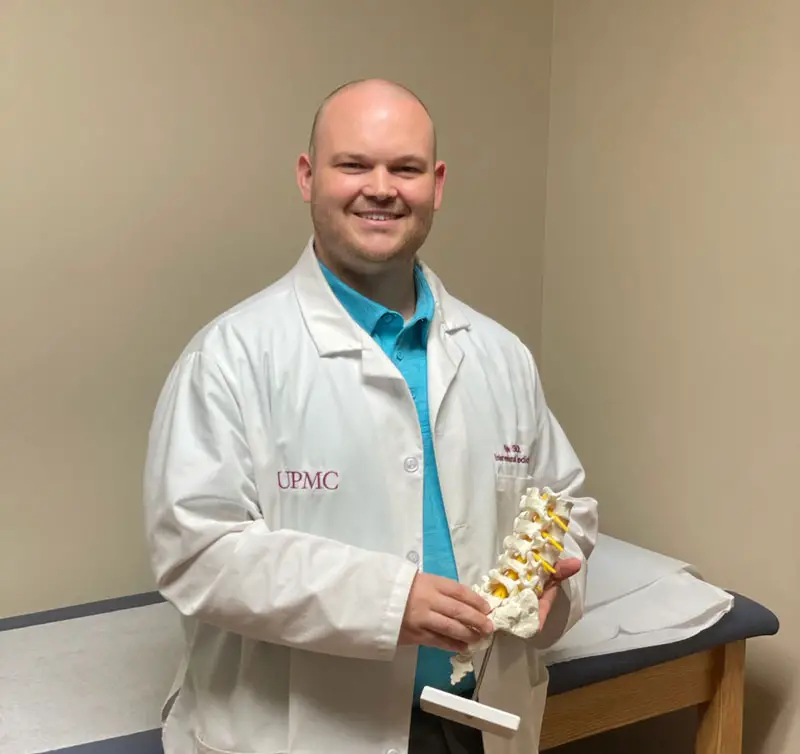 CLARION, Pa. (EYT) – Early experience shadowing at a regional hospital led one area native on a path to his own medical career.
CLARION, Pa. (EYT) – Early experience shadowing at a regional hospital led one area native on a path to his own medical career.
Dr. Kyle Shilk grew up in Elk County and graduated from Ridgway High School.
“I was able to do a lot of job shadowing at what was then St. Mary’s Hospital,” Shilk told exploreJeffersonPA.com.
“I got a lot of exposure to the healthcare field there which led to my interest in anesthesia.”
After high school, he moved on to get his undergraduate degree at the University of Pittsburgh. He went from there to the Lake Erie College of Osteopathic Medicine and then did a residency, focusing on anesthesiology, in Syracuse, New York.
However, after his residency he switched gears a bit, going a year-long fellowship on interventional pain techniques.
“I think it was the pain management standpoint that attracted me (to the fellowship), but another reason I went from anesthesia to that was to be able to touch base with patients more.”
Shilk noted he enjoys the opportunity to get to know his patients more, whereas, in the field of anesthesiology, he only got to meet patients briefly.
“I like getting to develop more of a relationship with patients and I found creating that continuity of care more fulfilling.”
After he finished up his fellowship in 2018, he decided to return to western Pennsylvania and discovered an opportunity that attracted him to UPMC Northwest. He noted that UPMC’s stellar reputation, along with a location near to his wife’s family in Clarion County made it a good match.
He started at UPMC Northwest in July 2018 in the anesthesiology department, but he was then able to develop an interventional pain practice beginning in summer 2019.
“It has really blossomed from there,” he noted.
After starting in Seneca, the practice now also has space at the building housing the UPMC Urgent Care Center in Clarion, behind Walmart.
According to Shilk, one of the difficult aspects of pain management is the all-too-common misconception that opioids are still the best or most common way of treating pain.
“People have this idea that going to a pain clinic means getting opioids, but we often kind of steer away from that to other options.”
Shilk said when a patient comes to an interventional pain physician, the first goal will be for the doctor to learn about all aspects of the patient’s issues so they can consider a multitude of modalities that may help.
“That could be a combination of things, from medication management to procedures to physical therapy or even injection therapy.”
He noted that they most often see patients who have received a referral from their primary care physician or another specialist, but noted that patients can self-refer, as well.
On a first appointment, a patient at the clinic can expect to sit down and discuss their pain complaints as well as a detailed history of what has been tried so far in terms of treatment. Then there will most often be a review of imaging or the ordering of new imaging before he can tailor a plan to fit the patient’s needs.
According to Shilk, a patient’s preferences are also taken into consideration, as some patients may not be willing to consider some options, such as injections.
“The key to it all is learning about the patient and tailoring their treatment.”
While opioids aren’t a primary focus in contemporary pain management, Shilk noted they are still a possible aspect for some patients.
“We try to avoid them most times, but sometimes they are part of a plan. We usually treat them with a conservative approach on only escalate if necessary.”
He said he will always have a discussion with a patient about the risks and benefits of treatment involving opioids before prescribing them.
“They certainly aren’t benign. There are a lot of risks like building tolerance, the risk of addiction, and even the possibilities of diversion or misuse. If they’re part of a treatment, we do a lot of fine-tuning to try to de-escalate from them as soon as possible.”
While opioids are still one possibility, Shilk said he’s more focused on finding the very best possible combination of treatments for each patient.
“We’re a full-service clinic and we try to provide the same level of care you would get in a bigger city. We can even do procedures from cervical spine to lumbar spine and anywhere in between. We’re not limited in that capacity. And we’re always available to anyone who has questions.”
Copyright © 2024 EYT Media Group, Inc. All rights reserved. Any copying, redistribution or retransmission of the contents of this service without the express written consent of EYT Media Group, Inc. is expressly prohibited.









